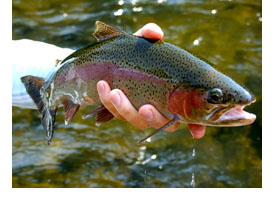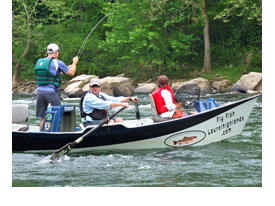Written by Ernie Pribanic
March is a hard month for the Western-Pennsylvania trout angler. Stricken with a surliness know only to those who have been denied the thing which they most desire for the better part of an Appalachian winter, they find themselves sitting haggardly in front of their computers, monitoring with doubtful eye the USGS gauges that correspond to their favorite spring time haunts. (At least, I do.)
People often ask me, obviously at times other than those when I’m wearing that March-spawned frustration upon my surly visage, “So what does the Youghiogheny’s foremost and most authoritative fishing guide look for before heading out to the river in the spring?” (They say that. They really do.)
Paflyfish's very own Dave Kile posited this question to me recently and asked if I might provide my answer in writing. Gracious fellow that I am, I reply thusly:
Upper Yough: (south of the Mason-Dixon, Maryland license required)
Ideal CFS for the wade-fisher is right around 300 or below. Of primary interest on this stretch of river is the four-mile catch and release area below the Brookfield Power plant. Brookfield Power releases cold water into the river here, creating a year-round fishery.
While this piece of water is a smaller version of the middle Yough below, it is still, by Eastern standards, a large piece of trout water, and you want to avoid it at higher flows.
Middle Yough: (below Youghiogheny River Lake--confusing isn’t it?)
You need to think of this stretch of river as having two sections: the dam to the Casselman River is section A, and the Casselman River to Ohiopyle is section B. Popular opinion says that section A can be waded safely at 1200 cfs or below, but this angler likes it best between 500 and 900 cfs. Check the USGS gauge at the dam for current flows.
Below the Casselman (and thanks to the Casselman), you have to check the gauge below Confluence. I won’t wade fish this piece of river unless it is at 1500 cfs or below. The determining factor is the amount of water coming north out of Maryland: if the Army Corps is running a lot of water from the dam, over 1000 cfs for instance, and you have the Casselman adding another 1000 cfs to the river, the Middle is out for all but the stout of heart.
Gear: (what to throw in you quiver)
For spring time fishing on the Yough, no matter which section you choose, I like a five and sometimes--if throwing bigger bugs--a six. If you know that you are going to be fishing streamers, a full sinking line is not a bad choice either.
As the season progresses, a nine-foot four weight can be a good choice for dry fly fishing on the Middle, and the Upper becomes perfect water for pitching dries with your favorite three or four weight.
Bugs hatches o’ plenty)
hatches o’ plenty)
You’ll find the typical spring bugs on both the Middle and the Upper, though the Upper is the buggier of the two. Midge hatches are a given on warm days throughout February and March, and if the water levels oblige, you’ll likely find fish working them in slower water and tailouts. Generally, by March, black stones, brown stones, and blue wing olives are common sights on both the Middle and the Upper River as well. Dry fly fishing is typically better on the Upper than the Middle throughout spring, though. This is generally due to water levels: when the Middle is high, you’ll have to work harder to find rising fish as most of their eating seems to get done below the surface.
On the Upper, you’ll find all the major mayfly species; while on the Middle, caddis, olives, march browns, and crane flies are what’s for dinner through April and May. Both sections have good populations of Green Drakes as well provided you find the right habitat for that particular burrower.
River Information and Guide Services:
For river information, hatch charts, or to book a guided trip on the Upper Yough and other Maryland waters, check out www.springcreekoutfitter.com.
For river reports or to book a guided float trip on the PA side, contact Ernie Pribanic or Jim DiBiase at www.laurelhighlandsguideservices.com
I want to thank Ernie for his contributions in writing this post. - Dave Kile


